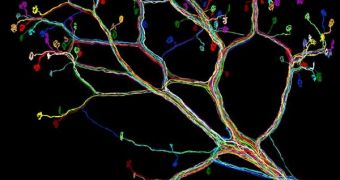When researchers finally announced that they had managed to sequence the entire human genome, that news was indeed groundbreaking. The momentous achievement led to numerous innovations in medicine, and will most likely continue to do so for a long time. Now, scientists are aiming for the cherry on the cake, which is mapping the entire human brain, to produce a wiring diagram. That means that the researchers want to learn how neurons interact between themselves, and how each group uses available neural pathways of relaying electrical impulses, LiveScience reports.
But the challenges facing such efforts are truly monumental. Until now, researchers have done this “manually,” looking for how certain pathways interact and relate to each others. But in order to be able to map the large machine that is the human brain, the experts will need to devise a computer model that could scan the connections and discover correlations. However, doing this presents its own difficulties. For example, analyzing the correlations between the 302 neurons of the tiny worm C. elegans took more than 12 years to do. Considering that the human brain has over 100 billion neurons, one could easily argue that
But the real issue is the tens of trillions of synapses that form between these neurons need to be charted too. This alone means that the computing power needed for such an effort would be massive. A computer-automated process is, however, the only possible alternative for producing usable results before our species dies out. “In the cerebral cortex, it's believed that one neuron is connected to 10,000 others,” Massachusetts Institute of Technology-based (MIT) computational neuroscientist Sebastian Seung says. He is also the leader of a new collaboration, which seeks to increase the speed at which connectomes, or the wiring diagrams, are produced.
What the team plans to do is endow machines with the ability to create their own neuron-tracing algorithms, which the computers could then use to solve all manner if intricate neural connections, regardless of their complexity. But the thing is that experts can only analyze small slices of tissue from the brain, while some neurons are known to have connections that stretch over several centimeters. Max Planck Institute neuroscientist Viren Jain is optimistic – the expert believes that, at the current rate, it will take several tens of thousands of work-hours to figure out the connections within just one cubic millimeter of brain.

 14 DAY TRIAL //
14 DAY TRIAL //